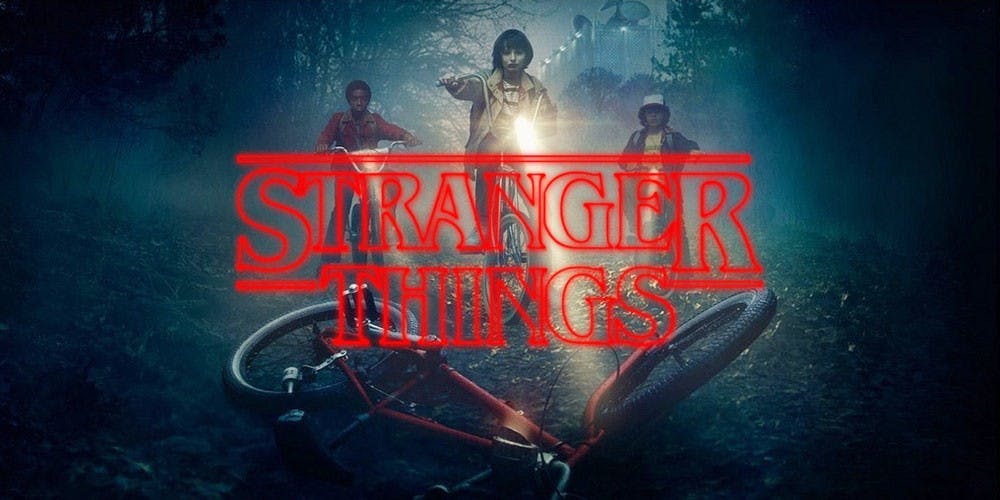Smart kids and broken adults live in a small town with dark secrets – of course, full of monsters, both human and otherwise.
These may sound like the trappings of a classic tale by Stephen King, but Matt and Ross Duffer (AKA the Duffer Brothers) use these familiar ingredients to create something unique in their Netflix original horror series, “Stranger Things.”
The story begins in the fictional town of Hawkins, Indiana – the Duffers’ own little Castle Rock – in 1983 with the disappearance of 12-year-old Will Byers (Noah Schnapp, “The Peanuts Movie,”2015), who vanishes from his home under suspicious and possibly supernatural circumstances after a particularly grueling “Dungeons & Dragons”campaign.
Leading the charge to find Will are his mother Joyce, a convincingly distraught Winona Ryder (“Show Me a Hero,”2015), and the alcoholic local sheriff Jim Hopper (David Harbour, “Black Mass,”2015), who has the uncanny ability to punch his way out of any tough situation despite the haze of booze and pills.
Conducting their own search are Will’s friends and “D&D”compatriots Mike, Dustin and Lucas played by the amazingly named Finn Wolfhard (“Supernatural,”2015), Gaten Matarazzo (“The Blacklist,” 2015) and Caleb McLaughlin (“Shades of Blue,” 2016), respectively, and prove that talented child actors do exist.
These kids are portrayed with the sort of honesty rarely seen in media. They are smart and competent without being depicted as miniature adults. The portrayal of childhood is reminiscent of classic ’80s movies such as “The Goonies,” “The Lost Boys” or “Stand by Me,” an actual Stephen King adaptation. Their dialogue is a treat for period pop culture enthusiasts, regularly referencing “Star Wars,” “Lord of the Rings” and “X-Men” to explain their current predicament.
In their search for Will, they stumble on a new friend who goes by Eleven; a young girl with a shaved head, hospital gown and a connection with the government agency located on the outskirts of town, which Chief Hopper is investigating for the Byers case.
She also has telekinetic superpowers – think “Akira” meets “Carrie” and “Firestarter,”two more of King’s works. Millie Bobby Brown (“Grey’s Anatomy,” 2015) turns in a stellar performance as the laconic Eleven, managing to nail both her immense strength and vulnerability simultaneously.
Another subplot of the show involves Mike’s sister Nancy (Natalia Dyer, “Long Nights Short Mornings,” 2016), Will’s brother Jonathan (Charlie Heaton, “As You Are,” 2016) and the local bad boy Steve Harrington (Joe Keery, “Henry Gamble’s Birthday Party,”2015) – who looks remarkably similar to Jean-Ralphio from “Parks and Recreation” – as they conduct their own investigation. It begins like a low-rent John Hughes movie and pays off surprisingly well by the season’s end.
One of the series’ greatest achievements is its commitment to the period setting. Not only are the fashion and decor on point, but the production itself also seems as if it could have taken place in the ’80s.
It lacks the referential “wink at the camera” quality of period pieces such as “Mad Men,”a show about the ’60s that was made in the last decade. The only qualm about the production of “Stranger Things” would be some very obvious CGI used to depict some of the supernatural elements in the show. It is reminiscent of – yet somehow poorer looking than – the fungus in the 1993 “Super Mario Bros.”movie.
The show is also very well paced, told in eight tight episodes referred to as “chapters,” hopping between the large ensemble cast and their respective storylines, all of which are engaging and add to the overall plot.
“Stranger Things” has much to offer. Film buffs will love spotting the references to their favorite ’80s classics and admire the stylistic homages to legends like Steven Spielberg and John Carpenter.
Fans of King are already predisposed to enjoy these tropes that have been popping up in his stories for years and may regard this series as more in the spirit of King’s work than many of his straight up adaptations.
David Tunis-Garcia is the assistant arts editor and can be reached at david.garcia@ubspectrum.com. Follow him on Twitter at @davidubspectrum





